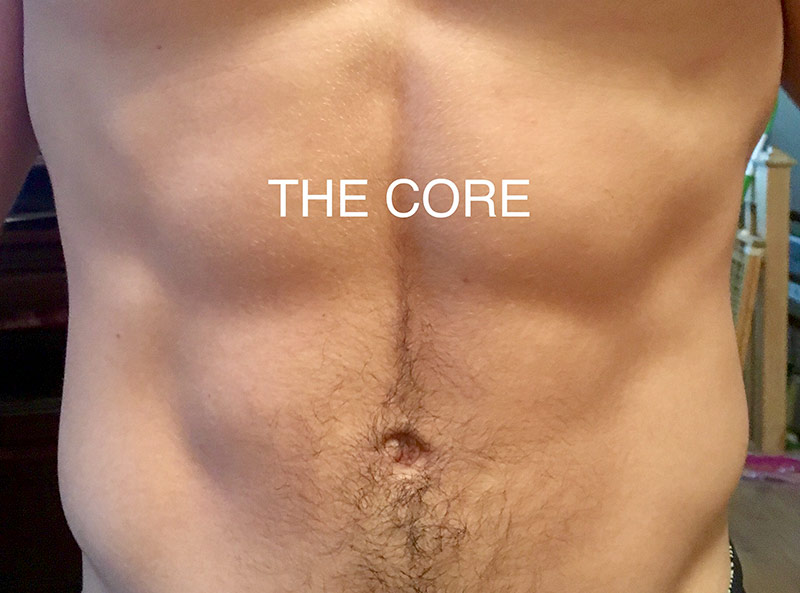Strength that originates in the core can be transmitted to and amplify the strength in our extremities. This transfer and amplification of energy is the true essence of power. Core is defined as “the most central or Important part of something”. It is fitting that we describe the area between our armpits and our pelvic floor as our “core”. Core muscles are integral to our ability to sit, stand, walk, and run. The core muscles stabilize our trunk so we can lift, push, and pull with power. These tissues generate the force necessary to sneeze and cough; they create the stability needed for our extremities to kick a soccer ball, throw a baseball, carry our groceries, or perform ballet. Weakness in these important muscles can result in chronic pain, diminished function, and sub-par athletic performance . First we must identify the principal components of this powerhouse, and then we can explore ways to strengthen the core and thus promote stability. The rectus abdominus, Internal and external obliques, Transversus abdominis, erector spinae, latssimus dorsi and the scapular stabilizers are principal components of the core. Imagine this area as a three dimensional cylinder, We can begin to understand the forces that can be generated from and controlled by engagement of these muscles. Each of these muscles has unique and independent functions. The common thread in these muscles is the ability to position and stabilize the trunk and allow for maximized strength and function in the upper and lower extremities.
Many people find it difficult to sit or stand with a neutral posture. Core control begins with the ability to contract the trunk muscles and align the spine in its most neutral position. Stability presents quite a challenge particularly for those who spend long periods of time during their day in a sitting position. I have developed an exercise to help one learn how to contract the core muscles in a sequence that can be transitioned to ideal sitting or standing posture. This exercise can be performed by any person at any time. It is helpful to practice each of the five movements independently before attempting to coordinate them in the “Supine Mountain” . To begin the exercise, lie flat on the floor with the palms facing upward. It can be helpful to lay on a yoga mat or a towel for comfort.
SUPINE MOUNTAIN EXERCISE
- Abdominal pull: visualize the abdominal muscles between the most prominent aspect of your hipbones. You should feel this exercise take place in this area. Pull the belly button down towards the spine. Imagine using those same muscles to pull your two hip bones towards each other as if they were elevator doors closing. Avoid movement of the pelvis and the ribs. Hold the contraction and count to five. Attempt to isolate this movement to the lower belly. Repeat this exercise for three minutes, holding each contraction for a 5 count.
- Rib pull: pull the lower ribs inward and downward imagining you can snap the lower ribs to the upper hip bones. Perform this upper abdominal wall exercise without moving your shoulders or your hips. This is a contraction your body uses naturally to sneeze or cough. It can be helpful to lightly cough as a training tool to recruit the appropriate muscles. As with the previous exercise, holds the contraction for five seconds then relax. Repeat for three minutes focusing on the quality of the exercise.
- Scap set: visualize the muscles between your shoulder blades. Gently draw the shoulder blades inward and slightly downward as if you were talking your shoulder blades into your back pockets. Hold this contraction and count slowly to five. Relax. Resist the tendency to arch your back or draw the shoulders toward the earlobes. Repeat this exercise for three minutes.
- Chin pull: gently pull the chin in and down as if you were going to create a “double chin” Notice that the neck lengthens from the crest of your shoulders to your hairline. Hold this contraction for five seconds. Relax. Repeat the exercise for three minutes.
- Heels of fire: Tighten the muscles of both legs pressing the knees flat into the floor and pressing the heels away from the body while imagining that you are “shooting flames out of your heels.” The legs should be very active and straight. Hold for a five count then relax. Repeat for three minutes.
Now comes the real challenge. We are going to put all five of these exercises together in an organized sequence that begins with the core. The exercise is called Supine Mountain because your body becomes strong and straight with the exercise. Supine mountain
Lie flat on the floor with the palms facing upward. Pull the lower belly in and down imagining your hipbones closing like elevator doors. Hold
Pull the ribs in and down as if you can snap the lower ribs to the upper hip bones. Hold Squeeze the shoulder blades in and down as if you were tucking your shoulder blades into
your back pocket hold.
Lengthen the back of the neck by pulling the chin in and down. Hold
Tighten the legs by pressing the knees into the floor and pulling the toes up towards your nose. Imagine shooting flames out of your heels. Visualize being as long as possible from your heels to the crown of your head. Focus on maintaining the neutral whore as he pulled her head and the feet away from the body. Count to slowly to 10 holding the strong straight posture. Relax. Repeat 10 times.
While this exercise can be quite challenging, it should never be painful. In fact, it usually feels great when you release from the supine mountain posture. Give it a try! Your body will love you for it.

